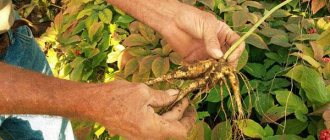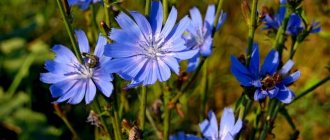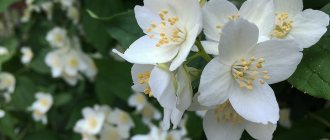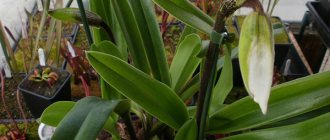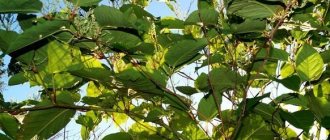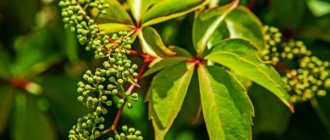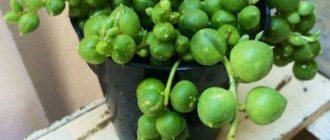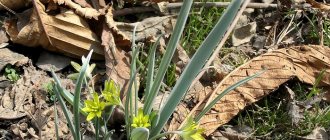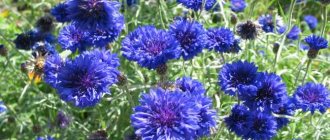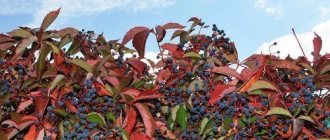Reproduction and development of the cross spider
The mating season of crosses occurs in autumn, when sexually mature males wander through the forests in search of a female sitting in her web. Having found a suitable option, the male cross weaves a thread from the edge of the web, which serves as an escape route and at the same time an invitation to mate. The female recognizes such vibration as a signal for reproduction and leaves her network, and immediately after mating is completed the male dies.
Cocoon of the cross spider
Female crosswort with cocoon. Photo credit: Graham Calow
The fertilized female cross spider builds a cocoon of soft silky threads, where she very soon lays eggs. She keeps the cocoon with herself for several days, and then hides it in a secluded place, hanging it in the cracks of the walls of residential buildings or under the bark of trees, where the cocoon will safely overwinter. After this, the female dies.
The offspring are born in the spring, and by summer the young spiders are already able to reproduce.
Photo by: R. Berg
Photo taken from travelswithmusti.net
Collection and preparation
Both the roots and above-ground parts of the weed have healing properties. Harvesting is carried out during periods of maximum content of useful substances in raw materials.
The collection of ragwort roots is carried out during seed ripening. They are dug up. For subsequent harvesting, only thin roots are cut off. The raw materials are dried and then completely dried.
The above-ground parts of the groundsel should be harvested during flowering. Subject to collection:
- leaves;
- flowers;
- stems.
The raw materials are dried in a well-ventilated and dark place.
Cross spider description, characteristics, structure
Senecio in homeopathy
The cross spider is a fairly small spider, however, females are much larger than males: their length ranges from 1.7 to 4 cm, and the size of males is from 1 to 1.1 cm. The body of the cross spider is covered with a yellowish chitinous shell. brown in color, which is shed during the next molt.
Like most arachnids, the cross spider has 10 limbs:
- 4 pairs of walking legs, at the ends of which there are claws,
- 1 pair of pedipalps, which perform the function of recognizing and retaining prey,
- 1 pair of chelicerae, which are needed to capture and kill prey. The spider's chelicerae are directed downward, and their hooks are directed inward.
Photo by: Alvesgaspar
On the last segment of the pedipalps in adult males there is a copulatory organ, which, before mating, is filled with seminal fluid and inserted into the spermatheca of the female.
Chelicerae of the cross. Photo by: Mike
The cross spider has 4 pairs of eyes, although it sees very poorly and distinguishes only blurry silhouettes, light and shadow. This deficiency is more than compensated for by a well-developed sense of touch, represented by tactile hairs scattered over the entire surface of the body.
Some hairs react to chemical stimuli, others perceive air vibrations, and others pick up sounds.
Photo by: Mike
The abdomen of the cross spider is round and devoid of segments, its upper part is decorated with a cross.
On the lower part of the abdomen there are 3 pairs of arachnoid warts containing about a thousand glands that produce threads for various purposes: for building trapping nets, arranging a shelter, weaving a cocoon.
Photo by: Michael Gäbler
Cross spiders, like most spiders, have external digestion: they are unable to digest food themselves, so they are forced to build trapping networks. The cross spider injects digestive juice into the victim it encounters, wraps the prey in a web cocoon and waits until the “dinner” is digested and turns into a nutrient solution that can be drunk.
The respiratory organs of the cross spider are located in the abdomen. They are represented by a pair of pulmonary sacs with a large number of leaf-like folds. There is air inside the folds, and hemolymph circulates through them (this is the name of the liquid that is found in the vessels of spiders instead of blood), enriched with oxygen. In addition to the pulmonary sacs, the respiratory organs include two bundles of trachea-tubules, which open with a hole on the underside of the abdomen.
Araneus viridiventris
The circulatory system of the cross spider is not closed. The heart is located in the dorsal part of the abdomen, in appearance it resembles a long tube, large blood vessels extend from it. From the anterior end of the heart, which has three pairs of holes, ostia, the anterior aorta departs, branching into arteries. The terminal branches of the arteries pour hemolymph into the body of the spider, which washes all the internal organs of the spider, transporting oxygen and necessary nutrients to them.
When hemolymph circulates through the pulmonary sacs, gas exchange occurs, then the hemolymph enters the cardiac pericardium and through the ostia into the heart itself. The hemolymph of the cross contains a copper-containing pigment - hemocyanin, which has a blue color.
Crosswort Araneus marmoreus. Photo by: PiccoloNamek
The excretory system of the cross spider is represented by coxal glands and malpighian vessels. Malpighian vessels in the form of tubes are nothing more than blind protrusions of the intestine, and they open into the intestine of the spider, located between the midgut and hindgut. They allow metabolic products to be absorbed from the body cavity of the cross.
The coxal glands are a pair of sac-like structures located in the cephalothorax. A system of canals departs from them, which ends with excretory ducts at the base of the walking legs.
Araneus circulissparsus. Photo by: Donald Hobern
The life cycle of the cross spider, depending on the species, is about 1-2 years.
Rules for propagating godsons at home
Fatshedera home care and transplantation
Senecio can be propagated by sowing
- seeds,
- cuttings
- using layering.
Cuttings
The simplest is cuttings with green twigs. In this case, you need to cut off the top of the shoot (about 8–10 cm), then 2–3 lower leaves are removed, and it is recommended to dry the cut for several hours so that liquid stops oozing from it.
- The cuttings are planted in small pots filled with sandy soil.
- The containers are placed in a warm and bright place.
- The soil mixture is usually not moistened; it is only lightly sprayed.
- When rooting takes place, young ragus plants are transplanted into separate pots of 2–5 units - this will in the future become the key to the decorative appearance of the grown bush.
Using layering
If senecio shoots are creeping or they droop towards the soil, then they can be used for layering. In this case, containers with a substrate suitable for this succulent are placed next to the pot of the mother specimen.
- The shoots are carefully laid on the ground from above and secured with stiff wires or a regular hairpin.
- After a short period, young roots appear in the places where the branch comes into contact with the substrate, and when the active development of the layer begins, it is recommended to carefully separate it from the bush and continue caring for it as usual.
Seed propagation
When seed propagation is used (which is quite rare), then seeds are used that appear under indoor conditions, which practically never happen. However, even if you have planting material, you need to be sure of its freshness, since the seeds quickly lose their germination properties.
It is recommended to soak the seeds before planting and germinate them a little before sowing in the ground. Several seeds are placed in one bowl at once, the soil used is typical for growing senecio. After planting, the soil is slightly moistened with a spray bottle.
As soon as it is noticed that the seedlings are forming cotyledons, it is recommended to transplant them into separate pots with drainage at the bottom and selected soil.
tutknow.ru
How to grow from seeds?
The easiest way to grow ragwort from seeds is self-sowing. If you like this plant and don’t care where it grows, you can let propagation take its course. The seeds are easily dispersed by the wind (like dandelion). Bushes grown in the wrong place can either be replanted or weeded out.
Seeds of graceful groundsel without stratification have low germination.
When sowing them for seedlings, this procedure must be carried out. With self-seeding, nature itself will take care of this. If you don't trust your plants to reproduce on their own, there are three ways to do it under control:
- Sow the seeds directly into the ground in the desired location.
- Buy seedlings at the market.
- Grow it yourself.
On sale you can find hybrids (F1) of graceful groundsel. It is not recommended to let them self-sow.
You can collect your own seeds in the fall or purchase them at the store. Growing ragwort seedlings is not particularly difficult - it is not a capricious plant. But still, certain conditions must be observed. There are two ways to stratify the seeds of this plant.
Method 1 (one month before sowing):
- melt the snow and soak two cotton pads in melt water;
- Place ragwort seeds on one of them, cover with a second disk and place them in a zip-lock bag;
- place the bag of seeds under the freezer in the refrigerator (temperature should be 1 - 5 oC) for a month;
- once every three days the bag should be opened briefly for ventilation;
- In the last week, use alternating temperatures, that is, keep it in the refrigerator at night and on the windowsill during the day.
Method 2:
- prepare a container with soil;
- sow seeds in moist soil;
- close the container with a lid or cling film;
- place in the refrigerator for a month;
- then proceed as in method 1.
How to grow graceful ragwort seedlings:
- After stratification, seeds are sown in late March - early April.
- The container is filled with soil, the seeds are laid out on the surface and sprinkled with a layer of 0.5 - 0.7 cm of soil.
- The surface is moistened with a spray bottle.
- Covered with a lid, film, glass.
- Ventilation is carried out periodically.
- When shoots appear, remove the cover.
- The soil should be moderately moist - neither drying nor waterlogging should be allowed.
- After two to three weeks, when the seedlings have three or four true leaves, the seedlings are plucked. To do this, you can use either separate cups or another container - larger and deeper.
- After two and a half months, the seedlings are planted in a permanent place.
Insect behavior
Motherwort
How does hunting happen? When any insect gets into the web, the vibration of the web is transmitted to the spider, and, approaching the victim, it kills it with poison. Then it entangles the victim with thin threads, which it pulls out of the abdomen using a pair of legs.
After this, the common cross bites the threads that hold the victim and moves to the center of the web for a meal. With the help of digestive juices that the spider injects into its prey, it is digested under its own shell. The spider can only suck out the semi-liquid contents and throw away the skin of the eaten insect. A spider can feast on dozens of insects at a time. Spiders are dangerous only to insects; their poison does not harm humans.
Common groundselSenecio vulgarisFamily Asteraceae
● It is a herbaceous biennial plant with few branches but straight stems. The alternate leaves are deeply pinnately dissected. Yellow flower baskets are equipped with false-ligulate petals, and the middle ones are tubular. The corymbose dense panicle is formed by collected flowers. The plant reaches from 20 to 40 centimeters in height.
● Common groundsel grows in almost many regions of the Russian Federation, mostly in the Non-Black Earth Region. For its excellent medicinal properties, it is popularly called life-giving herb. It blooms for quite a long time - from the end of May to August inclusive. This is the time to collect, the leaves, flowers and stems of common ragwort are used in folk medicine.
● The plant is rich in alkaloids senecionine and senecinine. These substances are quite toxic, so when preparing and using the drugs, the permissible doses should be strictly observed. Healers, herbalists and healers in Rus' have long used common ragwort as an anti-inflammatory, analgesic, sedative and anticonvulsant.
● In the villages of the central regions of Russia, peasants used an infusion of the herb for hysterical convulsions, as a result of which it received another name - paralysis. Most often used to relieve pain due to spasms, especially with renal and gastrointestinal colic. Modern official medicine has recognized common ragwort as one of the best antispasmodics.
Common groundsel - use in folk medicine
● Due to its anti-inflammatory and healing properties, crushed leaves of the plant are applied to abscesses, accelerating their maturation, resorption and healing. For the same purpose, it has found application not only for abscesses, but also for the treatment of hemorrhoidal cones in hemorrhoids and hardening of the mammary glands in mastopathy. To do this, a green, fresh plant is ground with sunflower or butter in a mortar and pestle and applied under a bandage, changing it twice a day.
● If it is not possible to grind the plant, then it can be used in the form of cold compresses with herbs, for example, to resolve hemorrhoids and panaritium. But at the same time, you should first chop the grass into large pieces, then in a meat grinder into smaller ones. Common ragwort is very useful for the treatment of spastic colitis and gastroenterocolitis.
● Russian peasants used the aerial part of the plant to treat helminthic infestations, especially enterobiasis (pinworms). Patients take one tablespoon of infusion 4-5 times a day during the day. In all cases of treatment with common ragwort, no side effects were identified.
Common groundsel - traditional medicine recipes
● Anticonvulsant and antispasmodic. Pour two cups of boiling water over a teaspoon of chopped herbs, insulate and leave for 60 minutes, filter. According to Art. spoon three to four times a day.
● Resorption of infiltrate. Grind the herb, apply to a piece of cloth and apply as a compress, changing the bandage twice a day (morning and evening).
● Compress for resolving lumps (tumors). Infuse two tablespoons of crushed leaves in half a liter of boiling water for half an hour and apply as a compress.
● Treatment of hypertension aggravated by hyperthyroidism. Grind and mix a teaspoon of common ragwort herb and two teaspoons of European grass, brew the mixture with 500 ml of boiling water, set aside for one hour, then filter. Take 50 ml of infusion three times a day before meals.
Be healthy, and may the Lord God bless you!!!
Main types
Euphorbia ragwort (Senecio anteuphorbium)
This deciduous shrub is a perennial. It can reach a height of 1 to 1.5 meters, has erect, succulent, rounded stems and one and a half centimeters thick. Greenish-gray small leaves reach 15–35 millimeters in length and 5–40 millimeters in width. Such lanceolate leaf plates are quite thick, in the upper part they have a short spine, while the central vein is highly developed. There are many basket-shaped inflorescences consisting of yellowish-white flowers.
Articulated groundsel (Senecio articulatus)
These not very tall deciduous shrubs are perennials. They are highly branched and can grow up to half a meter in height. The pale gray dissected branches are round in shape and about 2 centimeters thick. The pale gray thick leaves are either serrate-slit or dissected. They have a long petiole. There are several pieces of inflorescences of baskets forming scutes. The flowers are colored yellow.
Large-leaved groundsel (Senecio grandifolius)
These are evergreen perennial low trees or shrubs (from 2 to 3 meters in height). On the surface of the trunk, which is branched in the upper part, there are a huge number of warts. The elliptical leaves are saline-cordate or rounded at the base, reaching from 10 to 30 centimeters in length and 15 centimeters in width. They are notched along the edge, serrated with clearly visible teeth. The underside of the foliage is pubescent, and the front side is smooth. Small baskets of inflorescences are located in the upper part of the stems, while they form large and rather dense scutes. The flowers are yellow in color.
Gray's ragwort (Senecio greyi)
These are evergreen shrubs that are perennials, reaching a height of 2 to 3 meters and having white felt stems. The entire, leathery, ovoid leaves can have a length from 3 to 10 centimeters and a width from 1.5 to 3.5 centimeters. The underside of them is whitish-felt, and the front side is bare, but with a heavily pubescent central vein. The length of the petiole is from 1.5 to 3 centimeters. The basket inflorescences reach 2.5 centimeters in width and are corymbose. There are from 12 to 15 ligulate yellow marginal flowers. And many of the middle flowers are bell-shaped.
Nail-leaved groundsel (Senecio herrianus)
This perennial has weakly branched, creeping, rounded stems. Thick leaves reach 2 centimeters in length and 1.5 centimeters in width; there is a spur in the upper part. There are many lines on the surface of the leaf plate, and there is also a relatively wide stripe (from 2 to 3 millimeters). The inflorescences-baskets are small.
Klein's ragwort (Senecio kleinia)
These succulent evergreen shrubs are perennials and reach a height of 2 to 3 meters. Whorled, thick, jointed stems reach 40 centimeters in length. On their white surface there are dots and lines of dark color. The segments can be separated quite easily. In the upper part of the stems there are elongated elliptical leaves, reaching from 9 to 15 centimeters in length and from 1 to 2 centimeters in width. They are colored greenish-gray and are short-pointed. Small yellowish flowers are arranged corymbosely.
Red groundsel (Senecio pulcher)
This is a herbaceous plant that is a succulent and perennial. The length of its stems varies from 30 to 100 centimeters. The oblong-lanceolate leaf plates have jagged blades, stem, sessile, basal with petioles. There are 10 basket-inflorescences, which are arranged corymbosely and reach from 5 to 7 centimeters in width. The tubular flowers are yellow, and the reed flowers are deep lilac or pale purple.
Common groundsel (Senecio macroglossus)
This creeping perennial plant is a succulent. Its stem reaches a height of 3 centimeters and is sparsely branched and woody. The petiole is centimeter long. The spear-shaped leaves have 3–5 pointed lobes and can reach 8 centimeters in length. Flowers with a spherical middle part (diameter from 5 to 6 centimeters) and light yellow tongues can be arranged either singly or in pairs.
The variety “Variegatus” is the most popular among flower growers. It has chaotically located, yellowish spots on the leaf blade.
This plant is low maintenance and can lose all its foliage. The soil should be well drained and sandy. It is better to place it in a lighted, but not very sunny place. During intensive growth, it is necessary to water moderately, and in winter, stop watering completely. Propagated by cuttings. Cuttings take root easily in almost dry sand. The cutting should be placed in a warm place that is not exposed to direct sunlight.
Rooting groundsel (Senecio radicans)
These herbaceous evergreen perennials are succulents. They have creeping, branched, quickly rooting stems, reaching 30–50 centimeters in length. The alternate greenish-gray leaves are centimeter thick and 2–3 centimeters long. The leaf plate has a point on both sides, and on the surface there are longitudinal lines of a dark shade, as well as a dark green wide stripe. The inflorescences of the basket are arranged in pairs or singly. Quite a long peduncle. Snow-white flowers.
Creeping groundsel (Senecio serpens)
This evergreen shrub is a perennial. Its height is only 20 centimeters, and the rather thick bluish stems are 5–7 millimeters thick. In the upper part of the shoots there are linear-lanceolate leaves, which have a length of 3 to 4 centimeters and a width of 0.7 to 0.8 centimeters. The short pointed leaf blade is greenish-gray with a bluish tint. There are many baskets-inflorescences on the flowering stem. The flowers are painted white.
Rowley's ragwort (Senecio rowleyanus)
This evergreen plant, which is a perennial, is distinguished by its rapid growth. Thin hanging or creeping shoots can reach from 20 to 60 centimeters in length. The green leaf blades are spherical in shape with a pointed tip and a centimeter wide. The inflorescences are spherical in shape. The white flowers have a cinnamon scent.
Stapeliiformis (Senecio stapeliiformis)
These herbaceous succulent plants are perennials. The trunk is two centimeters thick and can reach 20 centimeters in height. It branches at the base, and there are a small number of spines on its surface. Small leaves (length 5 millimeters) are dark greenish-gray. The basket inflorescences are located on short peduncles. The color of the flowers is red.
Haworth's ragwort (Senecio haworthii)
This perennial is a bushy plant that can reach a height of 30 centimeters. Smooth, erect shoots can be either slightly branched or single. The spirally arranged leaf plates have a cylindrical shape, tapering at the ends. There is a white-silver felt layer on the surface of the leaves, and they can reach 3 to 5 centimeters in length. The spherical flowers are collected in the same inflorescence shape and are orange or yellow in color.
This plant is quite demanding to care for. Suitable soil should be well-drained and sandy. You need to place it in a well-lit place, but without direct sunlight. During the period of active growth, watering should be moderate, and in winter the plant needs dry maintenance. The fact is that such a plant is very sensitive to excess water. Propagated by cuttings. Dry sand should be used to root cuttings. The plant is placed in a warm place, protected from direct sunlight.
Godson - care at home
1.1.Reproduction, growing from seeds
Stem cuttings about 10 cm long, in spring or summer, rooting them in damp sand. Vegetative propagation usually does not cause difficulties and occurs quickly. Sowing of seeds is carried out in the spring.
1.2.How to care
Despite its fragility, this plant develops quite quickly and does not require special care. Senecio grows faster in warm conditions, as well as in the fresh air during the warm season. If the long stems of the ragwort become untidy and lose some of their leaves, cut them off at the base.
You may also be interested in:
- Clivia - photo of a flower, care at home, why a houseplant does not bloom, growing from seeds, replanting, reproduction, flowering time, signs and superstitions, growing, why the leaves turn yellow
- Crassula or money tree - home care, beneficial properties of the flower, plant flowering, types, diseases and pests, olives and replanting, soil for growing
- Metrosideros - photo, care at home, how to propagate a tree, flowering time, propagation - growing indoor plants from seeds, maintenance temperature, lighting, frequency of watering and soil composition
- Faucaria - photo, home care, description of species, propagation of succulents, how to root flower cuttings, growing temperature, lighting, frequency of watering and feeding
1.3.Flowering time
Spring. The flowering period is long - it will last about a month, but more often the ragwort is grown as an ornamental foliage plant.
What is known about this plant?
In nature, graceful groundsel grows in South Africa, which determines its drought resistance, unpretentiousness and love of sunlight.
Botanical description
- Elegant ragwort belongs to the Asteraceae family. It got its name for the compact structure of the bush.
- In nature it is a perennial. In our country, it does not survive the winter, so it is grown in open ground as an annual. As a perennial - as a houseplant.
- The height of an adult plant is 50 – 60 cm.
- The leaves are voluminous, smooth, divided, pinnate and lined.
- The shape of the leaf plates is rounded, blunt-pointed, toothed.
- The flowers are collected in double inflorescences forming corymbs.
- The colors of the flowers are bright and varied.
- The seeds are multirowed, hairy and multiple.
- The root has a rod shape.
- Flowering lasts from June to October (until the first frost).
By the way! Hybrid dwarf varieties have been developed that grow no more than 20 cm.
Appearance: description and photo
The inflorescences of graceful groundsel are formed at the ends of the stems. The entire plant is densely covered with miniature villi. The leaves have a light green color. At the base they are large, and the upper stem ones are small, but also curly.
Flowers, depending on the variety, can be of different sizes and colors, simple or double, smooth or velvety. They look like daisies or small daisies. The core of the flowers, regardless of their color, always has a bright yellow color.
Below you can see a photo of the plant:
Application in landscape design
Elegant ragwort can be grown in flower beds and alpine hills. It goes well in compositions with other colors. When planning a flower garden, we take into account not only the fact that this plant blooms beautifully, but also the decorative nature of its leaves.
High varieties of graceful ragwort can be grown for cutting, since the flowers do not wither in water for a long time, while maintaining freshness. Dwarf varieties are used for borders and edging of flower beds and other types of flower beds.
Important! In order for the graceful groundsel to bloom long and luxuriantly, it is necessary to remove faded heads.
Diseases and pests
Ragwort diseases are, first of all, diseases due to care errors. Lack of light and high temperatures in winter weaken the plant.
- Excessive watering, especially at low temperatures, causes root death and powdery mildew.
- Among the pests, when kept too dry, the spider mite becomes active. If the leaves wrinkle and dry out, you should urgently water the green part of the plant in the shower and also moisten the soil. You can spray with beer or diluted alcohol.
- Aphids are found on the plant in the summer when it is watered abundantly. If a sticky coating forms on the plant, insecticides must be applied, following the recommendations for use.
It is known that well-groomed plants rarely get sick, and when they do get sick, they cope with the disease without consequences.
Rowley's ragwort is a unique plant. Among the large number of ragworts, only this one has reduced round bead-shaped leaves. There are two more similar plants, some classify them as separate species, but more often they are considered under the species or variety of Rowley.
One of them is Herreyan's ragwort (Senecio Herreyanus), whose leaves are not round, but oval, located almost perpendicular to the hanging trunk. The second is lemon grass (Senecio citriformis), whose pointed-tipped leaves look like small green lemons. They are already being crossed with each other, hybrids are being created.
selo.guru
Possible problems
- The leaves become covered with brown spots and dry out. This can be facilitated by high temperature and low air humidity, insufficient watering and the presence of spider mites. It can also be the result of sunburn.
- Yellowish-brown spots on the foliage indicate overwatering or using too cold water.
- Lack of lighting provokes the appearance of small leaves that grow poorly and thin, elongated shoots.
- In variegated species, color is lost and they become a normal green color when there is insufficient light and a very small container in which they are planted.
- The leaves of Rowley's ragus begin to turn yellow, wrinkle and fall off when air temperatures are too high.
mrsad.ru
Varieties and photos
Each of the representatives of the genus fascinates with something unique to this plant. This includes the unusual shape of the leaves, pubescence, color scheme, and the size of the inflorescence-basket. There are more than 3,000 varieties of ragwort that grow successfully not only outdoors, but also at home. Below are photos, names and descriptions of ragwort species suitable for propagation and care at home.
Rowley
This is a perennial succulent that is also called "string of pearls". Rowley is better suited than other varieties for propagation and care at home, due to its intensive growth. It comes from the African Namib Desert. This variety is distinguished by the decorative appearance of green shoots, which, depending on the method of placement, either hang down or spread along the ground, covering the surface. The leaves are soft green in color, spherical in shape, 6 mm in diameter, which are strung in the form of beads on thin shoots.
Under favorable conditions, the plant produces a peduncle in May, with single small white flowers collected in a basket inflorescence and spreading a pleasant subtle aroma of cinnamon.
The root system of the Rowley variety is superficial, so the pots need to be wide and shallow. The optimal air humidity is 50-60%; there should not be an excess of nutrients in the soil.
The photo below shows Godson Rowley:
Ordinary
This is a perennial or biennial herbaceous plant, widespread in the countries of northern Eurasia. Common groundsel is considered an aggressive weed, so its spread is strictly controlled. It grows well on roadsides, fields, meadows, in forests and along paths, wastelands and sand dunes, rocks, walls and scree.
The stem is erect, slightly branched. The leaves are oblong, spatulate, slightly toothed at the edges. The end of the bent flowering shoot is crowned by a bell-shaped basket with yellow tubular-shaped flowers. Valuable honey plant. You can see what the Ordinary Raspberry variety looks like in the photo below:
Large tongue
This is a tall evergreen vine that at first glance resembles common ivy. The native land of the large-tongued ragus is the Natal province in South Africa, which is why the plant is also called “Natal ivy”. A distinctive feature is the spear-shaped leaves, reaching a length of 8 cm, which, like all succulents, are dense, thick, filled with moisture, covered with a waxy coating.
The leaves are located on long (up to 3 m), weakly branched and woody stems, attached with small purple petioles.
The color of the leaf blade is even green or variegated, there are spots and yellow-white stripes. The main vein has a reddish tint.
Flowering of large-tongued senecio occurs in winter, during which spherical axillary or apical (usually single) baskets with small yellow flowers appear on the plant. In the photo below is the variety Krestovnik Krupnoyakovy:
Flat-leaved
This is a tall perennial herbaceous plant, growing mainly in the Caucasus, at an altitude of 1500-2000 m above sea level. Flat-leaved groundsel forms thickets in tall grass meadows. Its few erect shoots have a ribbed surface. The height of the stems on which large leaves are located reaches 2 m. The upper leaves have an ovate-lanceolate shape, while the lower ones have a triangular-peaked shape. There is pubescence on the leaves and stems.
The plant blooms in the first half of summer, after which from August to September the seeds are warmed, which then spread by self-sowing. The inflorescences are large, paniculate-corymbose. Bright yellow tubular flowers are collected in cylindrical baskets.
rhombolifolia
Rhombolifolia is a perennial Caucasian rhizomatous plant with numerous erect stems, reaching 2.5 m in height. Habitat: mountain forests and pre-alpine lowlands, located at an altitude of 1500-2000 m above sea level.
Broadly ovate, alternately arranged petiolate leaves are covered with pubescence. The upper leaves are up to 8 cm long, and the lower ones are much longer - up to 30 cm.
The inflorescences are corymbose-paniculate, consisting of small yellow baskets. Tiny seeds with roots are carried by the wind.
Diseases and pests
Most often, these are gray rot and powdery mildew. Rot appears when there is high soil moisture, lack of light or in a too cool room.
Signs of the disease are dry spots with a yellow border.
For treatment, you need to treat the green pet with copper oxychloride and eliminate the causes of the disease.
Powdery mildew is characterized by a white coating on individual leaves and shoots of the plant.
Increased nitrogen content creates an additional risk of disease.
For healing, all diseased parts must be removed, and the entire plant must be treated with foundationazole in a 1:1 ratio with water.
Of the pests that most often parasitize gluing plants, three types can be distinguished:
- spider mite
- aphid
- mealyworms.
Spider mites only grow in dry and warm environments. Its presence is determined by the appearance of a thin cobweb on the inside of the leaf. The leaves themselves turn brown.
To kill the mite, the plant must be treated with Actellik. If there is a danger of infection, you need to humidify the air in the room and spray the ragwort with warm water.
Greenhouse aphids feed on the sap of leaves and shoots, causing them to turn yellow and dry. The inflorescences change color, and the buds may not bloom. The same control measures are used as against ticks.
Mealybugs (citrus and seaweed) lay eggs on senecio leaves, and the adults suck the sap from the leaves. An alcohol or soap solution can be used against insects.
If drastic measures are necessary, then karbofos emulsion will come to the rescue.
Composition and medicinal properties
The chemical composition of this plant indicates that it can be used for many diseases. The composition of the godson contains the alkaloids senecin, senecionine, seneciphylline, riddelline, as well as ascorbic acid and a nitrogen-free substance
It is important to note that the alkaloids that make up ragwort are
belong to toxic substances, therefore this plant must be used for medicinal purposes, strictly observing the permissible dosage. Ragwort also contains other complex substances, but they have not been well studied to date.
The medicinal properties of ragwort are due to its anticonvulsant, anti-inflammatory, hemostatic, disinfecting and wound-healing properties. As part of medications, ragwort can soothe a cough, regulate the menstrual cycle, and relieve constipation. Alcohol tincture of ragwort is used as a hemostatic agent. For hardening of the mammary glands (mastitis) and hemorrhoidal cones, godson decoction in the form of lotions is one of the most effective medicines. Well, we will tell you in more detail about the use of common ragwort in folk medicine later.
Useful Jacob's ragus (common) in nature and at home
Common groundsel , in Latin - senecio vulgaris, is a very common plant and grows throughout almost the entire territory of Eurasia and North America.
Article on the topic: Panama rubber tree - beneficial properties, description
In the wild it is known as a weed. Belongs to the Asteraceae family.
Sometimes the common one is called Jacob's ragwort, gluenia , or simply senecio (after its Latin name).
Its popular names are also often found - yellow thistle and life-giving herb . The ragwort as a genus includes many species.
They may look different, but they have one thing in common - poisonous juice. Despite this, senecio is considered a medicinal plant.
Reproduction
Spiders are dioecious insects. Their mating season is in August. After mating has occurred, the male, who did not have time to escape from the spider, dies. The female begins to weave a cocoon for eggs from the web, which she carries on herself, then hides it in a safe place. Egg laying occurs in autumn. With the arrival of spring, young insects begin to emerge from the cocoon. They reach sexual maturity at the end of summer, after which the spider that gave birth to them dies.
With the onset of maturity, the male spider begins to look for the female’s web, and having discovered it, he tries not to become prey. To avoid this, the spider prepares its retreat path by weaving a thread downwards from the edge of the web
After this, he begins to carefully pull the thread, which provokes the female to rush to search for the victim. The male spider hides using a woven thread
Similar games are repeated several times, after which the male and female mate. And if the spider loses its vigilance after mating, it can be eaten by the female.
The cocoon woven by the female contains from three hundred to eight hundred amber eggs. The eggs overwinter in a cocoon, and in the spring young spiders begin to emerge from them. They remain in the cocoon for some time, then crawl away to begin an independent life.
Small spiders have weak limbs, so it is more convenient for them to move from place to place, gliding on the web. The common cross hunts constantly; flies, mosquitoes, mosquitoes, midges, moths and aphids fall into its nets.
Structural features
The male cross has dimensions in the range of 8-10 mm, females are larger - 15-25 mm. The insect has four pairs of eyes, each of which looks in a different direction and provides the spider with a fairly broad horizon. Despite this, cross-haired people see poorly, they are myopic and are able to distinguish only shadows, movement, and the outlines of objects. But they have a keen sense of smell and taste. The spider's body is covered with hairs that sensitively detect any vibration and vibration.
The common cross has eight legs, its abdomen is round in shape, and white or light brown spots in the shape of a cross are visible on it. Long thin legs end in three claws.
Traditional medicine recipes with common ragwort
To make medicinal products, you need ragwort grass or its roots (they have a similar effect). Raw materials are collected at any time of the year, dried under a canopy, in the oven (temperature - 60-80 degrees). Fresh ragwort herb is also used for treatment.
For mastitis
When there is engorgement of the mammary glands, which happens during inflammatory processes, oil ointment with common ragwort will help. The fresh plant needs to be washed and ground into a paste. Combine in equal parts with vegetable or animal oil. Apply the ointment under a cotton bandage, wearing it constantly and changing it twice a day.
For bronchial asthma
Pour 10 g of dry raw material with 100 ml of vodka. Infuse the product for 14 days in the dark, then take 30 drops three times a day for 21 days.
For stomach ulcers
Brew a teaspoon of dry ragwort with 400 ml of boiling water and leave for an hour. After filtering, drink the infusion one tablespoon three times a day on an empty stomach. Course – 14 days.
For purulent acne
To make a painful, red pimple ripen faster, you need to apply crushed leaves of the plant to it. You can also steam the powder from the dry parts of the common ragus in boiling water. Apply the mixture to the problem area in the form of a mask, leave for half an hour, rinse. Repeat 2-3 times a day until the abscess breaks through. The same method of therapy is suitable for getting rid of felon, but in this case it is necessary to tie the plant mass on the finger with a bandage, leaving it for the day, and by night change the bandage to a new one.
From worms
To remove parasites from the body, you need to brew a tablespoon of godson grass with a glass of boiling water. Drink a tablespoon of infusion up to 5 times a day for 10 days. This method is especially suitable for the treatment of pinworms - enterobiasis. Large parasites cannot be dealt with without medication in this way.
For seizures
Pour a teaspoon of the plant into a thermos with two glasses of boiling water. Infuse the product overnight, then filter. Drink 30 ml four times a day until the convulsive syndrome stops. The same method of therapy is perfect for healing cramps in the abdomen and muscles.
For tumors
The following method is suitable not only for resolving externally localized tumors (benign), but also for treating bruises and hematomas. Infuse 2 tablespoons of ragwort in 300 ml of boiling water for an hour. After straining, moisten a cloth in the infusion, apply a compress under the film. Carry out treatment daily for at least 14 days.
For hyperthyroidism
Mix a tablespoon of common ragwort and 2 teaspoons of European grasshopper well, pour 500 ml of boiling water. Leave covered for an hour and filter. Drink 50 ml three times a day on an empty stomach for a month.
With scanty menstruation
If by the age of 40 the volume of menstrual blood begins to decrease with the regularity of menstruation, you can treat with ragwort tincture. Pour 40 g of dry raw material into 0.5 liters of vodka and leave for 14 days, shaking the product every day. At the end of the period, squeeze out the raw materials. Drink tincture 40 drops/day for at least a month.
From tracheitis
When a cough due to tracheitis (or bronchitis) does not go away for a long time, you need to make compresses on the back and chest with ointment based on ragwort. Grind dry or fresh raw materials, add equal parts of honey and animal fat. Mix everything thoroughly and apply to clean skin. Secure with film and a warm scarf. Leave for 2 hours. Repeat therapy daily until recovery.
For rhinitis
For a runny nose - viral or cold - you can use an infusion of common ragwort for instillation into the nose. Pour 50 ml of hot water over a teaspoon of raw material and leave until the liquid cools completely. Strain, drop 3 drops into both nostrils as often as possible (every hour). For allergic and vasomotor rhinitis, this method of therapy is not advisable.
For hypertension
For the treatment of hypertension, a collection with common ragwort is prepared. Equally combined are ragwort grass, licorice roots, knotweed grass, shepherd's purse, fireweed, wild rosemary, motherwort, yarrow, bud tea, and rose hips. Pour 300 ml of boiling water into 8 g of collection and leave for 3 hours. Then cook in a water bath for 10 minutes, let cool completely. Drink an hour before meals three times a day for up to 3 months.
Be careful, folk recipes do not replace qualified medical care. Before any traditional treatment, consultation with a doctor is strictly required!
https://recipehealth.ru
Using ragwort
Since ancient times, the plant has been used by healers in their potions. Ointments, decoctions, and infusions were prepared from the herb. Any bruise or abrasion was treated with powder or ointment. The plant contains a large amount of alkaloids in its tissues, therefore it is a good hemostatic agent.
In addition to them, the tissues contain ascorbic acid, carotene, nitrogen-free substances, and mineral salts. Raspberry is toxic because the juice contains toxic substances.
Despite this, the plant is actively used in the treatment of many diseases. Decoctions or infusions are anti-inflammatory and wound-healing agents. Compresses help to quickly ripen boils and ulcers.
A decoction of the herb has proven itself well as a diuretic. The decoction can also be instilled into the nose for prolonged runny nose or severe congestion.
When pus forms in the throat, you can make such a compress.
- Finely chop the ragwort root and mix with goat or badger fat.
- You can even use Vaseline.
- Apply the mixture to a flannel cloth and apply it to your throat.
- Wrap up and wear the bandage for up to 5-7 hours.
To prepare the infusion, you need to take 1 tsp. dry ragwort and pour 500 ml of boiling water. Cover with a cloth and leave for 60 minutes.
A decoction of ragwort is prepared in the following way.
- 1 tbsp. l. dried raw materials are mixed with 1 liter of water.
- Bring to a boil and simmer over low heat for 30 minutes.
- Next, the mixture is covered and kept for another couple of hours.
Contraindications
In addition to the healing properties, there are many side effects. Therefore, before taking drugs based on ragwort, you need to find out about the contraindications.
Attention! The plant should not be used in any form by children under 16 years of age, pregnant women or nursing mothers.
- Long-term use of drugs is also unacceptable: problems with the liver and nervous system may begin. Not for: patients with gastrointestinal pathologies, those who are sick with both acute and chronic diseases of the kidneys and adrenal glands.
- Do not use any medications for low blood pressure or diseases of the eyeball.
Since the ragwort plant is toxic and has contraindications, the frequency of administration and amount of the drug should be asked from the attending physician or specialist. If you feel signs of poisoning or illness associated with taking the drug, you should urgently go to the clinic.
The plant does not need planting or care. It grows on its own. Used as a medicinal herb for diseases. Has many contraindications. This is the kind of ragwort that grows like a weed.
Web
Only the female weaves a web to catch prey. Being in the center of the web or nearby, located on the signal thread, dangerous spiders wait for a catch. Most often, the prey is a fly or mosquito. When very large and inedible prey gets caught in the web, the spider releases it by breaking the web.
The caught catch is eaten immediately or carried away by the spider to a secluded place and entangled in a web.
The web woven by the female has exactly 39 radii, 1245 points at which the radii are attached to the spiral. The spiral has 35 turns. All the webs that spiders weave are identical. The ability to weave a web is genetic.
All the threads that form the network are very light, but at the same time very strong, which is what the inhabitants of the tropics take advantage of, using the web in the manufacture of nets or fishing gear. In addition, the spider's web has high elasticity.
In the process of creating a web, two types of threads are used. The spider weaves the frame and radii using strong, dry fibers that do not have an adhesive coating. The frame of the future web is stretched between the branches. After this, the spider weaves radial threads that diverge from the center to the edges, as well as an auxiliary spiral thread, which serves as the basis for creating a catcher spiral. At the end of this work, the cross spider is placed in the center, from where it lays a sticky web. It takes an insect about an hour to weave a net.
The use of ragwort in folk medicine
Traditional healers have been using ragwort for a long time to prepare medicines that can cope with many ailments. Thus, in folk medicine there is one French recipe that helps with convulsive twitching of the facial muscles. To get rid of cramps, crush the ragwort root in a mortar, mix in equal proportions with wax and apply to the face for 40-60 minutes. After 2-3 procedures, the problem of facial muscle twitching will completely disappear.
The medicinal properties of ragwort are usually more pronounced if used in the form of an infusion or decoction. However, both the juice of the plant and the powder of crushed leaves or roots are also an excellent medicine. To understand how to properly use ragwort at home, we suggest you familiarize yourself with the simplest and most effective traditional medicine recipes.
Tincture for stomach ulcers and abdominal pain
Preparation and use: pour 1 teaspoon of dried and crushed leaves of the plant into two glasses of boiling water, let it brew in a thermos for one hour, then strain through cheesecloth or a strainer and take 1 tbsp. spoon three times a day half an hour before meals.
Tincture for spasms and convulsions
Preparation and use: 1 tbsp. a spoonful of godson leaves is poured with half a liter of boiling water, left in a closed container for 2 hours, after which 1 tbsp is taken. spoon three times a day.
Tincture against worms
Preparation and use: pour a teaspoon of dried groundsel roots or leaves with two glasses of boiling water, let it brew for a couple of hours and take 1 tbsp. spoon twice a day - morning and evening.
Tincture for increasing semen in men
Preparation and use: pour 0.5 teaspoon of dried leaves of the plant with a glass of boiling water, let it brew and drink the prepared medicine throughout the day.
A decoction to normalize and reduce the pain of the menstrual cycle
Preparation and use: pour 15 grams of crushed and dried plant roots with 100 ml of alcohol, pour into a hermetically sealed container and leave for 5 days in a dry, dark place. Next, the tincture should be taken 30 drops three times a day. During menopause, ragwort tincture is taken in a volume of 50 drops three times a day.
Decoction for stuffy nose
Preparation and use: brew the roots of the plant at the rate of 1 teaspoon per 50 grams of water, cool and bury the nose at least three times a day.
Tincture for sore throat
Preparation and use: mix the pre-dried roots of the plant with honey or animal fat (not oil) in equal parts, apply to the throat, wrap a scarf on top and go to bed.
Powder for poorly healing wounds
Preparation and use: Grind the leaves of the plant in a coffee grinder and sprinkle the resulting powder on the wounds. This powder not only disinfects the wound, but also heals it well, preventing the formation of scars.
Decoction as a diuretic
Preparation and use: 0.5 teaspoons of crushed plant stems are poured into a glass of water, honey is added and drunk 1/3 cup three times a day after meals.
Contraindications for use
Considering the fact that the plant contains strong alkaloids, drugs based on it should be used in a strictly observed dosage. Poisoning with ragwort preparations is manifested by dizziness, vomiting, abdominal pain, headache, collapse and respiratory arrest, which can develop against the background of relatively mild general toxic phenomena. First aid for poisoning is artificial respiration, gastric lavage, oxygen inhalation.
The use of drugs with ragwort is strictly prohibited for glaucoma, diseases of the cardiovascular system, liver and kidneys.
Contraindications
There are quite a few contraindications for preparations made from ragwort. They cannot be used for organic diseases of the heart and blood vessels, when blood circulation is impaired, as well as in the presence of organic disorders in the functioning of the liver and kidneys. They are contraindicated for glaucoma. You should be wary of an overdose of the drug. In this case, palpitations and dry mouth occur, and the pupils dilate.
Recipes
- For stomach ulcers: one teaspoon of dry ragwort is poured into two glasses of boiling water. Leave for one hour, then strain. Take the infusion one tablespoon three times a day before meals.
- For abscesses, apply compresses. To do this, take fresh leaves of the plant (two tablespoons), pour half a liter of boiling water over them and leave for half an hour. The liquid is filtered and used for compresses.
- Hemostatic tincture of roots: twenty-five grams of crushed raw materials are poured with half a glass of seventy percent alcohol. Leave for two weeks, stirring regularly, then filter and squeeze. Take thirty to forty drops diluted in fifty milliliters of water, one to three times a day, fifteen minutes before meals.
Medicinal properties
The whole plant is used for medicinal purposes and can be collected all summer long. The grass should be dried in the shade, but with ventilation.
Beneficial substances found in the plant:
- ascorbic acid;
- seneciphilin;
- alkaloids;
- routine;
- senecionine;
- mineral salts.
In folk medicine, Senecio is used both externally and orally (internally).
Preparations containing this plant are used to stop bleeding and speed up wound healing.
When used orally, small doses of decoctions and tinctures stimulate the central nervous system.
But if the norm is exceeded, the effect will be the opposite.
Gluing is also used to treat stomach and duodenal ulcers, and is especially effective for internal bleeding.
Inflammatory processes in organs such as:
- large and small intestines;
- gallbladder.
Application[edit]
Use in medicineedit
Many types of ragwort produce alkaloids, including pyrrolizidine alkaloids, often their content is quite high, and therefore can cause poisoning in people and animals. But it is the high content of alkaloids that is the reason for the use of some types of ragwort as medicinal plants, as well as raw materials for the production of medical drugs.
Use in horticultureedit
When growing ragworts as garden plants, fertile, well-drained soil is required in most cases.
Annual species of ragwort are propagated by seeds (autumn planting is often used), perennial species by division in the spring, and shrubs by cuttings in the summer.
